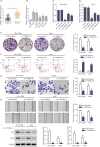Long non-coding RNA TRPM2-AS sponges microRNA-138-5p to activate epidermal growth factor receptor and PI3K/AKT signaling in non-small cell lung cancer
- PMID: 33209893
- PMCID: PMC7661873
- DOI: 10.21037/atm-20-6331
Long non-coding RNA TRPM2-AS sponges microRNA-138-5p to activate epidermal growth factor receptor and PI3K/AKT signaling in non-small cell lung cancer
Abstract
Background: Long non-coding RNAs (lncRNAs) can play pivotal roles in tumor progression by acting as microRNA (miRNA) sponges. This study aimed to investigate the association of a novel lncRNA, TRPM2-AS, with the miR-138-5p/EGFR axis in the development of non-small cell lung cancer (NSCLC).
Methods: Sixty NSCLC tissues and paired adjacent non-tumor tissues were analyzed. The relative expression levels of TRPM2-AS, miR138-5p, and epidermal growth factor receptor (EGFR) and the interactions between them were analyzed. The NSCLC cell lines NCI-H1299 and A549 were transfected with TRPM2-AS shRNA/pcDNA, and miR-138-5p mimics. Cell proliferation, migration, invasion, and apoptosis were examined in response to different transfection conditions. Dual-luciferase reporter assay was performed to identify the target interactions between TRPM2-AS, miR-138-5p, and EGFR. A549 cells stably transfected with shRNA were injected into BALB/c null nude mice to establish a tumor xenograft model.
Results: TRPM2-AS was up-regulated in NSCLC tumors and cell lines. Cell proliferation, migration, and invasion were inhibited in NSCLC cells treated with sh-TRPM2-AS, while apoptosis was induced. The targeting of TRPM2-AS by miR138-5p and miR138-5p by EGFR were validated with dual-luciferase reporter assay. TRPM2-AS was found to be negatively correlated with miR138-5p but positively correlated with EGFR. PI3K/AKT/mTOR was activated by pcDNA-EGFR but inactivated by miR-138-5p mimics. In the tumor xenograft mouse model, sh-TRPM2-AS suppressed tumor formation, reduced the expression of EGFR and Ki67, and promoted tumor cell apoptosis.
Conclusions: Our results suggested that TRPM2-AS can increase the levels of EGFR via sponging miR-138-3p; this promoted NSCLC cell proliferation, migration, and invasion in vitro, and exacerbated tumors in vivo. These findings highlight TRPM2-AS/miR-138-5p as a potential target for reducing drug resistance in patients with NSCLC.
Keywords: Epidermal growth factor receptor (EGFR); TRPM2-AS; miR-138; non-small cell lung cancer (NSCLC); phosphatidylinositol 3-kinase (PI3K).
2020 Annals of Translational Medicine. All rights reserved.
Conflict of interest statement
Conflicts of Interest: All authors have completed the ICMJE uniform disclosure form (available at http://dx.doi.org/10.21037/atm-20-6331). The authors have no conflicts of interest to declare.
Figures









References
-
- Global Burden of Disease Cancer Collaboration , Fitzmaurice C, Abate D, et al. Global, Regional, and National Cancer Incidence, Mortality, Years of Life Lost, Years Lived With Disability, and Disability-Adjusted Life-Years for 29 Cancer Groups, 1990 to 2017: A Systematic Analysis for the Global Burden of Disease Study. JAMA Oncol 2019;5:1749-68. 10.1001/jamaoncol.2019.2996 - DOI - PMC - PubMed
-
- Ma LY, Xie XW, Ma L, et al. Downregulated long non-coding RNA TRPM2-AS inhibits cisplatin resistance of non-small cell lung cancer cells via activation of p53- p66shc pathway. Eur Rev Med Pharmacol Sci 2017;21:2626-34. - PubMed
LinkOut - more resources
Full Text Sources
Research Materials
Miscellaneous
